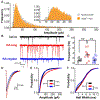Increased GABA transmission to GnRH neurons after intrahippocampal kainic acid injection in mice is sex-specific and associated with estrous cycle disruption
- PMID: 35868435
- PMCID: PMC9455811
- DOI: 10.1016/j.nbd.2022.105822
Increased GABA transmission to GnRH neurons after intrahippocampal kainic acid injection in mice is sex-specific and associated with estrous cycle disruption
Abstract
Patients with epilepsy develop reproductive endocrine comorbidities at a rate higher than that of the general population. Clinical studies have identified disrupted luteinizing hormone (LH) release patterns in patients of both sexes, suggesting potential epilepsy-associated changes in hypothalamic gonadotropin-releasing hormone (GnRH) neuron function. In previous work, we found that GnRH neuron firing is increased in diestrous females and males in the intrahippocampal kainic acid (IHKA) mouse model of temporal lobe epilepsy. Notably, GABAA receptor activation is depolarizing in adult GnRH neurons. Therefore, here we tested the hypothesis that increased GnRH neuron firing in IHKA mice is associated with increased GABAergic drive to GnRH neurons. When ionotropic glutamate receptors (iGluRs) were blocked to isolate GABAergic postsynaptic currents (PSCs), no differences in PSC frequency were seen between GnRH neurons from control and IHKA diestrous females. In the absence of iGluR blockade, however, GABA PSC frequency was increased in GnRH neurons from IHKA females with disrupted estrous cycles, but not saline-injected controls nor IHKA females without estrous cycle disruption. GABA PSC amplitude was also increased in IHKA females with disrupted estrous cycles. These findings suggest the presence of an iGluR-dependent increase in feed-forward GABAergic transmission to GnRH neurons specific to IHKA females with comorbid cycle disruption. In males, GABA PSC frequency and amplitude were unchanged but PSC duration was reduced. Together, these findings suggest that increased GABA transmission helps drive elevated firing in IHKA females on diestrus and indicate the presence of a sex-specific hypothalamic mechanism underlying reproductive endocrine dysfunction in IHKA mice.
Keywords: Electrophysiology; Epilepsy; GABA; Gonadotropin-releasing hormone; Hypothalamus; Neuroendocrinology.
Copyright © 2022 The Authors. Published by Elsevier Inc. All rights reserved.
Conflict of interest statement
Declaration of Competing Interest
The authors declare no competing financial interests.
Figures






Comment in
-
Sex on the Brain: Reproductive Comorbidities in Temporal Lobe Epilepsy.Epilepsy Curr. 2022 Nov 29;23(1):58-60. doi: 10.1177/15357597221135717. eCollection 2023 Jan-Feb. Epilepsy Curr. 2022. PMID: 36923330 Free PMC article. No abstract available.
Similar articles
-
Sex-Dependent Changes in Gonadotropin-Releasing Hormone Neuron Voltage-Gated Potassium Currents in a Mouse Model of Temporal Lobe Epilepsy.eNeuro. 2024 Oct 21;11(10):ENEURO.0324-24.2024. doi: 10.1523/ENEURO.0324-24.2024. Print 2024 Oct. eNeuro. 2024. PMID: 39375030 Free PMC article.
-
Epilepsy-associated increase in gonadotropin-releasing hormone neuron firing in diestrous female mice is independent of chronic seizure burden severity.Epilepsy Res. 2022 Aug;184:106948. doi: 10.1016/j.eplepsyres.2022.106948. Epub 2022 May 20. Epilepsy Res. 2022. PMID: 35690025 Free PMC article.
-
Dynamic and Sex-Specific Changes in Gonadotropin-Releasing Hormone Neuron Activity and Excitability in a Mouse Model of Temporal Lobe Epilepsy.eNeuro. 2018 Sep 24;5(5):ENEURO.0273-18.2018. doi: 10.1523/ENEURO.0273-18.2018. eCollection 2018 Sep-Oct. eNeuro. 2018. PMID: 30255128 Free PMC article.
-
GABAergic regulation of the HPA and HPG axes and the impact of stress on reproductive function.J Steroid Biochem Mol Biol. 2016 Jun;160:196-203. doi: 10.1016/j.jsbmb.2015.11.019. Epub 2015 Dec 9. J Steroid Biochem Mol Biol. 2016. PMID: 26690789 Free PMC article. Review.
-
Sexual dimorphism in the GABAergic control of gonadotropin release in intact rats.Neurosci Res. 2003 Aug;46(4):399-405. doi: 10.1016/s0168-0102(03)00099-3. Neurosci Res. 2003. PMID: 12871761 Review.
Cited by
-
Female-specific pituitary gonadotrope dysregulation in mice with chronic focal epilepsy.Exp Neurol. 2023 Jun;364:114389. doi: 10.1016/j.expneurol.2023.114389. Epub 2023 Mar 28. Exp Neurol. 2023. PMID: 36990138 Free PMC article.
-
Sex and Estrous Cycle Stage Shape Left-Right Asymmetry in Chronic Hippocampal Seizures in Mice.eNeuro. 2023 Jun 5;10(6):ENEURO.0041-23.2023. doi: 10.1523/ENEURO.0041-23.2023. Print 2023 Jun. eNeuro. 2023. PMID: 37248046 Free PMC article.
-
Characterization of the intrahippocampal kainic acid model in female mice with a special focus on seizure suppression by antiseizure medications.Exp Neurol. 2024 Jun;376:114749. doi: 10.1016/j.expneurol.2024.114749. Epub 2024 Mar 11. Exp Neurol. 2024. PMID: 38467356 Free PMC article.
-
PHLPP1 regulates region-specific astroglial mitochondrial fission in response to oxidative stress in the male rat hippocampus.Sci Rep. 2025 Jul 18;15(1):26077. doi: 10.1038/s41598-025-12214-0. Sci Rep. 2025. PMID: 40681773 Free PMC article.
-
Mechanisms linking neurological disorders with reproductive endocrine dysfunction: Insights from epilepsy research.Front Neuroendocrinol. 2023 Oct;71:101084. doi: 10.1016/j.yfrne.2023.101084. Epub 2023 Jul 27. Front Neuroendocrinol. 2023. PMID: 37506886 Free PMC article. Review.
References
Publication types
MeSH terms
Substances
Grants and funding
LinkOut - more resources
Full Text Sources
Molecular Biology Databases

